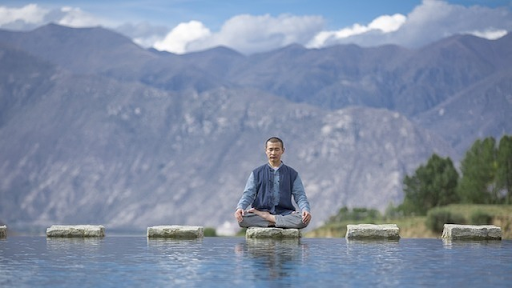You must have often heard about the terms mindfulness and meditation. Many people use these words interchangeably. Are they the same? In this blog, UEF helps you understand the difference between mindfulness vs meditation, practical techniques and how to start them with simple exercises. Learning how to practice mindfulness and meditation will help you build a more flourishing life.
What is Meditation and Mindfulness?
Meditation and mindfulness are practices that cultivate a mental state or quality of awareness in you. Mindfulness is a quality of being present. However, meditation refers to the structured practice of training your mind. And understanding the difference between mindfulness and meditation can help you choose the approach that fits your lifestyle.
Mindfulness meditation combines both. It helps you by bringing your conscious attention to the present moment while also using some meditation techniques. In short, what are meditation and mindfulness? It is the practice of enhancing your mental clarity, focus, and presence in your everyday life.
What is the Difference Between Mindfulness and Meditation
The main difference between mindfulness vs meditation is in their nature and application. Here is the difference between mindfulness and meditation explained simply. Mindfulness is a way of being. It is a state of awareness and practice of being fully present in the moment even while doing anything. Meditation is a focused way to train your mind. You can be mindful without meditating. So while mindfulness and meditation support each other, they are not the same. Both can help you improve spiritual awareness and life quality.
How to do mindfulness meditation: Are they the Same?
Mindfulness meditation is the combination of both concepts. This form of meditation lets you become more mindful. To do mindful meditation, sit in a quiet space, breathe and observe your flow of thoughts and emotions without judgment. Mindfulness can be practised during activities, but mindful meditation needs you to set aside time for it.
Mindfulness vs. Meditation: Key Differences & Practices
Mindfulness means being aware of what is happening right now. Your thoughts, breath, body and even the sounds around you. It is about paying attention without getting lost in it. You don’t need to sit in silence or follow a routine to practise mindfulness. You can be mindful while drinking tea, walking in the park or doing your chores. It is a state of presence.
Meditation is a more formal practice. It is something you set time aside for. You sit still, focus and watch your breath or repeat a mantra or follow a guided voice. Meditation is a way to train the mind to calm inner noise. Most meditation practises use mindfulness too. Mindfulness on its own doesn’t need structure.
Types of Mindfulness
Here are a few types of mindfulness practices that are easy.

1. Mindful Breathing
Mindful breathing is the easiest for a beginner. You sit still and observe your breath without trying to change it. When your mind wanders, bring your focus back to breathing patterns. Mindful breathing is the base of most meditations and yoga practises. You can do this for 5-10 minutes daily.
2. Mindful Body Scan
To do a body scan mindful practice, lying down is the best and most relaxed position. First, do some mindful breathing. Then, check each part mentally from your toes until you reach your head. Check if each body part is relaxed, painful or tensed. The body scan is a good grounding method. It will also relax you mentally and help you become body-aware. Think of it as a symbolic fire burning through your layers of distractions.
3. Mindful Eating
Mindfulness can be practised while eating also. You need to slow down as you eat. Notice the texture, aroma and taste of the food. Also, focus on how your body feels as you eat. Mindful eating can improve your digestion and help you build a better relationship with your food and your body.
4. Mindful Gratitude Reflection
Think about things that you are thankful for, whether big or small. You can write it down or make a journal about it. This will make you appreciate life’s positive things more, connecting you to deeper symbols of spiritual grounding like the cosmic tree.
Types of Meditation
Here are different types of easy meditations that you can practice.

1. Mindfulness Meditation
Get comfortable and observe your breath and thoughts without trying to control them. This is how to do mindfulness meditation. This practice will improve both mental and emotional clarity. Mindfulness meditation and yoga together improve overall well-being.
2. Guided Meditation
In guided meditation, you listen to instructions from a guide. This is the best way for beginners to start practising meditation.
3. Loving-Kindness Meditation
Loving-kindness meditation is also known as metta meditation. It is about kindness to self and to everyone. You have to repeat phrases like” may I be happy”, or “may I be healthy” in this meditation practice. First, you wish them for yourself, then for your dear ones and then for strangers and everyone else. Metta meditation opens your heart and heals. In many cultures, such meditations are supported through rituals and religious wear that reflect devotion.
4. Transcendental Meditation
This is a more structured way of meditation. In transcendental meditation, you repeat a mantra to reach deep inner stillness. You can practice this for 15-20 minutes twice a day.
Benefits of Practicing Mindfulness and Meditation Together
When you are practicing mindfulness and meditation together, you can significantly improve your mental and physical well-being. By combining these approaches, you strengthen your ability to stay present and reduce stress. It also helps you improve your focus.
Mental Benefits of Mindfulness and Meditation
When you practice regularly, mindfulness meditation can provide you with a healthy mental state or quality of awareness. It will help you lead to improved clarity. You will gain your emotional stability and overall mental wellness.
- Reduced Stress
When you are engaging in mindfulness and meditation, it helps you lower your stress by calming your mind and reducing your body’s stress response.
- Improves Mood
Regular practice of mindfulness meditation can uplift your mood. It will help you promote a more positive and balanced emotional state.
- Enhances Focus & Concentration
Both mindfulness and meditation enhance cognitive performance. They help you improve your attention span and concentration.
- Decreases Rumination
Cultivating mental clarity, mindfulness, and meditation can help you reduce repetitive, negative thought patterns.
Physical Benefits of Mindfulness and Meditation
In addition to mental benefits, mindfulness and meditation also contribute to your better physical health and overall well-being.
- Lowers Blood Pressure
Mindfulness meditation can lower your blood pressure. They help you by promoting relaxation and reducing your stress hormones.
- Improves Sleep
When you are practicing mindfulness and meditation before bedtime, you can easily improve your sleep quality and duration.
- Manages Chronic Pain
With regular mindfulness meditation, you can help yourself in managing your chronic pain by altering perception and reducing discomfort.
- Supports Immune Functions
Mindfulness and meditation strengthen your immune system. They help you by enhancing your body’s ability to fight illness.
Conclusion
Many people fall into the trap of false narratives around the practices of mindfulness and meditation. Few even believe that meditation is only for monks and that mindfulness is just a trend. Both these practices are based on science and ancient wisdom. Research[1][2][3] shows that regular practice of mindfulness meditation can improve sleep, immunity, emotional and heart health. You do not have to sit for hours or be spiritual for these practices. Anyone can do it, anytime.
If you are looking to introduce these concepts to your children, UEF’s flourishing child program is a great place to start.
Frequently Asked Questions on Mindfulness Vs. Meditation
1. Is meditation and mindfulness the same thing?
No. Meditation and mindfulness are not the same. Mindfulness is a mental state. Meditation is a technique that helps develop mindfulness.
2. Can you be mindful without meditating?
Yes. You can be mindful without meditating. You can practice mindfulness while doing your daily activities like walking, eating etc.
3. Does meditation make you mindful?
Yes. Meditation types like mindfulness meditation help improve mindfulness.
4. Is mindfulness or meditation better for anxiety?
Both mindfulness and meditation help with anxiety. Mindfulness helps you notice your anxious thoughts without reacting to them. Mediation helps to calm the nervous system.
5. How long should I meditate or practice mindfulness each day?
Even a few minutes daily of mindfulness meditation can provide you with significant mental and physical benefits. Gradually, you should aim for 20–30 minutes for some deeper results.
6. How can I stay consistent with mindfulness and meditation practices?
You can create a daily routine for yourself. Start by using reminders, and make sure you start with small steps. Mindfulness becomes easier with consistency. Therefore, gradually integrate it into your daily life.
7. Is it normal to feel distracted during meditation or mindfulness practice?
Yes, distractions are common. The key is to gently bring your attention back. You should focus on reinforcing your mental clarity and the quality of being present.
Related reads
Can you be spiritual but not religious | What It Means To Flourish | What Christian Teachings Say About Flourishing Communities | What Is Spirituality According to Indian Philosophy
Personal Development | False Narratives | Flourishing | World Tree | Divine Justice | Power of Words | World Music | Charioteer | Religious Clothing
About the author:
Akhilesh Gupta is the founder of theUEF Foundation and a Fellow of the Harvard Advanced Leadership Initiative. He previously served as senior managing director at Blackstone and held leadership roles at Reliance Industries and Hindustan Unilever.

